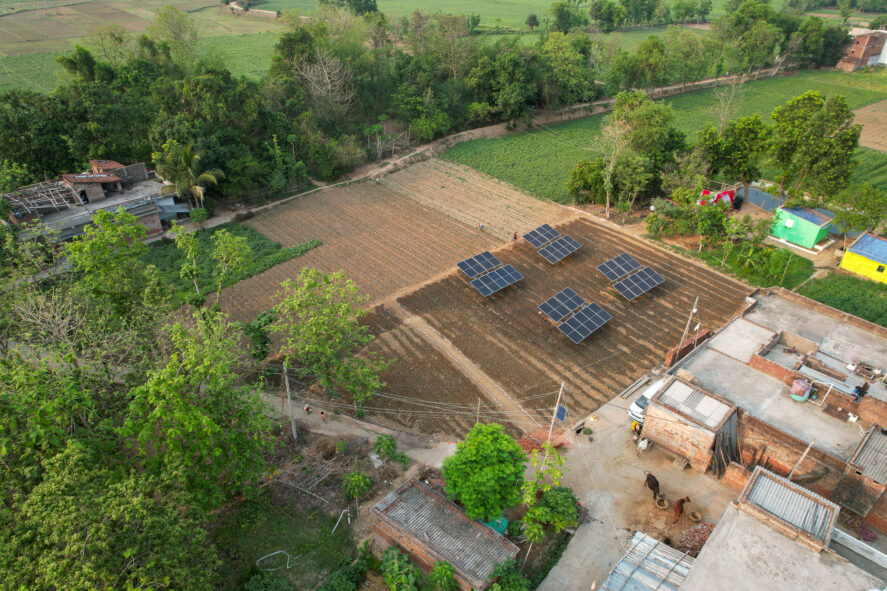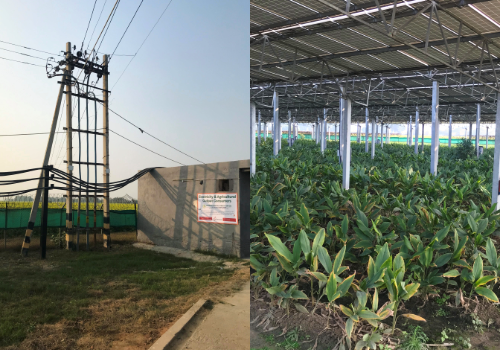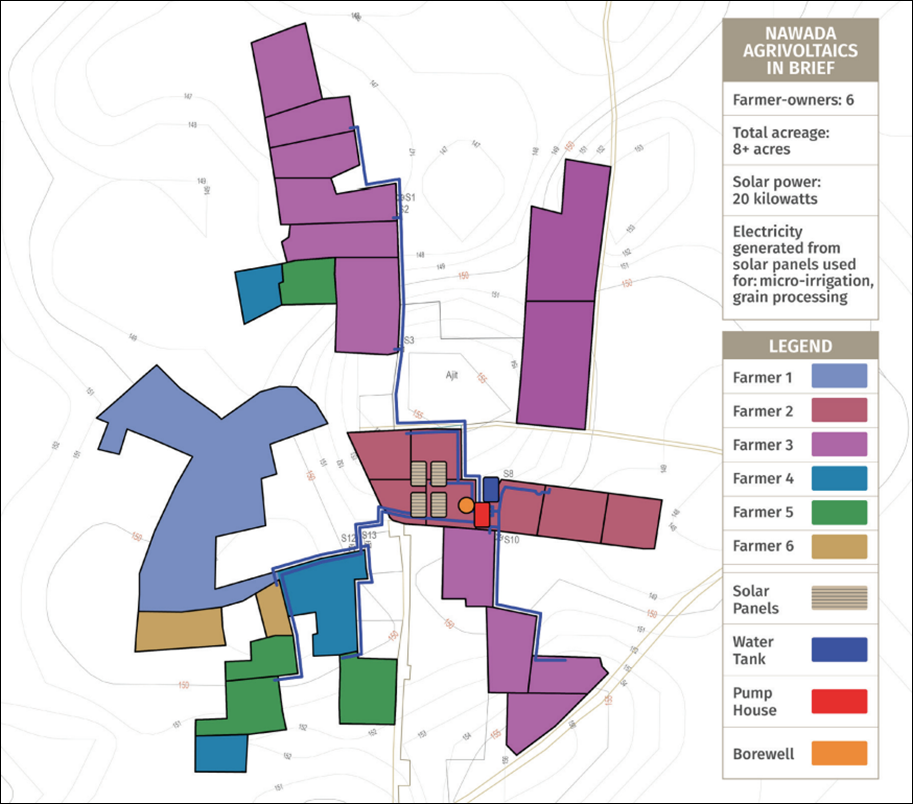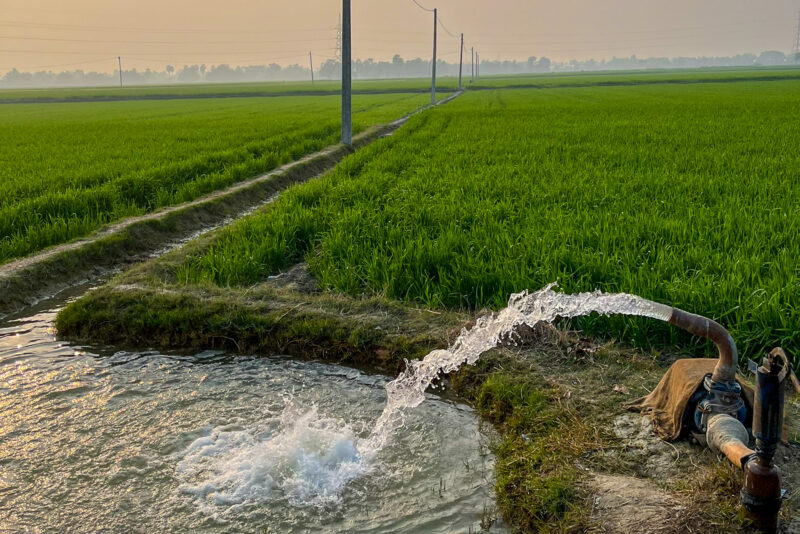A Multi-Use Agrivoltaics Model for Smallholder Communities

India, like many countries around the world, faces the daunting challenge of increasing food production to feed its growing population while attempting to mitigate the effects of climate change by reducing its greenhouse gas emissions. In this context, agri-photovoltaics (agrivoltaics for short) is an important technology for offsetting the emissions associated with agricultural production, but it must be adapted to India’s smallholder context.
In this article, we delve deeper into the multi-use aspects of community-based agrivoltaics. In a previous blog post, we discussed this technology as a component of the Tata-Cornell Institute’s “Zero-Hunger, Zero-Carbon Food Systems” project, which aims to devise solutions that increase agricultural productivity while reducing greenhouse gas emissions in rural areas of Bihar. Community-based agrivoltaics involves a broader perspective on agrivoltaics that goes beyond merely growing crops alongside or underneath solar panels.

Larger agrivoltaics facilities like this one near Delhi require corporate investments and need to be located near high-capacity transmission lines. Here, turmeric is grown under high solar panels.
Solar farms provide an excellent opportunity to substitute fossil-fuel-derived electricity with renewable energy and thereby reduce greenhouse gas emissions and air pollution. However, the associated removal of precious agricultural land from food production is a major concern. This is especially critical in farmland-constrained places like Bihar, where fertile land is intensively managed to meet critical local food needs in densely populated rural areas. The concept of agrivoltaics addresses this concern by co-locating growing crops with solar panels. With large-scale power generation as the primary goal, such systems are typically part of a corporate investment and connected to the electrical grid near major transmission lines. The crops grown under the panels need to be adapted to low-light conditions, such as high-value turmeric and ginger.
One model for agricultural use of solar power is built around policy incentives (e.g., Pradhan Mantri Kisan Urja Suraksha evam Utthaan Mahabhiyaan [PM-KUSUM]) that promote solar power for irrigation. These are very small systems that only focus on powering irrigation pumps, which then don’t require fossil fuels or electric grid connectivity. But since the solar power is only used for short periods during irrigation, much of the generated electricity remains unused.
Community agrivoltaics is a different approach where members of rural communities band together to link the advantages of solar power generation with a multitude of uses. It offers several benefits:
- Earnings are accrued within the local community rather than by external corporate entities
- The use of land, water and solar energy is optimized within a community
- Food production and farm revenues are enhanced rather than removing farmland from active use
Community agrivoltaics in Nawada
As part of the Zero-Hunger, Zero-Carbon Food Systems project, the Tata-Cornell Institute built a multi-use, community agrivoltaics installation in Nawada, Gaya District, Bihar. We worked with a local NGO, PRAN, to facilitate community relations, and with Jain Irrigation on the technical installations. The solar system forms the central element of the project, but there are much broader agronomic and socioeconomic dimensions that distinguish it from typical agrivoltaics installations.
Six farmers invested in the project by forming and registering the Nawada Agrivoltaics Producer Group and paying for part of the costs of the solar and water management systems. Thanks to the agrivoltaics system, their 8 acres of farmland were developed for micro-irrigation and fertigation (they previously used flood irrigation, which is less efficient). This provided an opportunity to expand their production into a dry season (zaid) that otherwise required more than the available groundwater.

In Nawada, a small solar array supports a much larger (8 acre) footprint of enhanced crop production, as well as other food production needs.
In addition to more efficient water use, an added benefit of micro-irrigation (drip or micro-sprinklers) is better soil conditions for crop growth, as it prevents soil collapse after flooding. The farmers also decided to grow more diverse sets of crops, including a relay cropping system (mung bean-okra-banana) in the same field. Yields and crop income were thereby significantly enhanced.
Another opportunity with the community agrivoltaics site is the use of excess energy for value-added food processing, in this case, grain milling for flour. Many additional power uses are possible, like charging small electric vehicles (scooters, auto-taxis, etc.), food preparation appliances that reduce the use of cow dung for cooking (which can otherwise be used to enhance soil health), and food preservation through refrigeration.
Challenges to agrivoltaics adoption
The multi-use, community agrivoltaics concept offers more than growing crops under solar panels. It is a holistic approach to enhancing community resources for food production and other needs. Its focus is on keeping the benefits of solar technologies local. Yet, despite the obvious opportunities, there are still barriers to adoption. A financial constraint is the upfront cost, which takes time to see a return on investment. This can in part be addressed through appropriate subsidies and incentives. While some of these exist even now, their implementation in Bihar hasn’t been satisfactory.
In all, community agrivoltaics is a comprehensive approach to enhancing the use of land, water, solar energy and human resources to advance local agriculture and food production for the benefit of the community itself.
Other challenges include prohibitive state policies on the generation and use of electricity at the community level. Electricity for irrigation from the traditional grid is highly subsidized, and renewable energy sources may not be financially competitive, despite the other benefits. Also, Bihar does not facilitate net-metering for small solar facilities, which would otherwise allow excess energy to be sold to the grid. Furthermore, the existing regulations make selling power from an agrivoltaics installation to local businesses prohibitively expensive. Battery storage would allow nighttime electricity use, especially for charging small electric vehicles, but it is expensive. Finally, we identified a need for intermediary advisory and technical support to bridge the gap between farmer communities and the companies that sell or finance agrivoltaics installations. This would create opportunities for entrepreneurial initiatives and government technical service providers.
In all, community agrivoltaics is a comprehensive approach to enhancing the use of land, water, solar energy and human resources to advance local agriculture and food production for the benefit of the community itself. Our prototype installation in Nawada is a good model to prove the benefits and challenges. It is broader than the common concept of agrivoltaics that mostly involves growing crops under solar panels. In the next phase, our project will further analyze policy opportunities to encourage the adoption of this technology model.
Milorad Plavsic is the manager for strategic initiatives at TCI.
Harold van Es is a TCI faculty fellow and a professor of soil science in the Section of Soil and Crop Sciences at Cornell University.
Feature image: At the TCI agrivoltaics site in Nawada village, solar panels are co-positioned with crops on farmland. Power generated by the panels is used to provide micro-irrigation and other services to six small farms.





